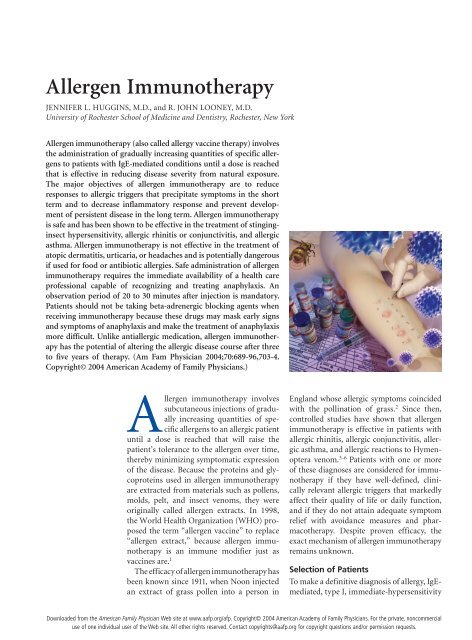Immunotherapy Safety for the Primary Care ... - U.S. Coast Guard
Immunotherapy Safety for the Primary Care ... - U.S. Coast Guard
Immunotherapy Safety for the Primary Care ... - U.S. Coast Guard
You also want an ePaper? Increase the reach of your titles
YUMPU automatically turns print PDFs into web optimized ePapers that Google loves.
Allergen <strong>Immuno<strong>the</strong>rapy</strong><br />
JENNIFER L. HUGGINS, M.D., and R. JOHN LOONEY, M.D.<br />
University of Rochester School of Medicine and Dentistry, Rochester, New York<br />
Allergen immuno<strong>the</strong>rapy (also called allergy vaccine <strong>the</strong>rapy) involves<br />
<strong>the</strong> administration of gradually increasing quantities of specific allergens<br />
to patients with IgE-mediated conditions until a dose is reached<br />
that is effective in reducing disease severity from natural exposure.<br />
The major objectives of allergen immuno<strong>the</strong>rapy are to reduce<br />
responses to allergic triggers that precipitate symptoms in <strong>the</strong> short<br />
term and to decrease inflammatory response and prevent development<br />
of persistent disease in <strong>the</strong> long term. Allergen immuno<strong>the</strong>rapy<br />
is safe and has been shown to be effective in <strong>the</strong> treatment of stinginginsect<br />
hypersensitivity, allergic rhinitis or conjunctivitis, and allergic<br />
asthma. Allergen immuno<strong>the</strong>rapy is not effective in <strong>the</strong> treatment of<br />
atopic dermatitis, urticaria, or headaches and is potentially dangerous<br />
if used <strong>for</strong> food or antibiotic allergies. Safe administration of allergen<br />
immuno<strong>the</strong>rapy requires <strong>the</strong> immediate availability of a health care<br />
professional capable of recognizing and treating anaphylaxis. An<br />
observation period of 20 to 30 minutes after injection is mandatory.<br />
Patients should not be taking beta-adrenergic blocking agents when<br />
receiving immuno<strong>the</strong>rapy because <strong>the</strong>se drugs may mask early signs<br />
and symptoms of anaphylaxis and make <strong>the</strong> treatment of anaphylaxis<br />
more difficult. Unlike antiallergic medication, allergen immuno<strong>the</strong>rapy<br />
has <strong>the</strong> potential of altering <strong>the</strong> allergic disease course after three<br />
to five years of <strong>the</strong>rapy. (Am Fam Physician 2004;70:689-96,703-4.<br />
Copyright© 2004 American Academy of Family Physicians.)<br />
Allergen immuno<strong>the</strong>rapy involves<br />
subcutaneous injections of gradually<br />
increasing quantities of specific<br />
allergens to an allergic patient<br />
until a dose is reached that will raise <strong>the</strong><br />
patient’s tolerance to <strong>the</strong> allergen over time,<br />
<strong>the</strong>reby minimizing symptomatic expression<br />
of <strong>the</strong> disease. Because <strong>the</strong> proteins and glycoproteins<br />
used in allergen immuno<strong>the</strong>rapy<br />
are extracted from materials such as pollens,<br />
molds, pelt, and insect venoms, <strong>the</strong>y were<br />
originally called allergen extracts. In 1998,<br />
<strong>the</strong> World Health Organization (WHO) proposed<br />
<strong>the</strong> term “allergen vaccine” to replace<br />
“allergen extract,” because allergen immuno<strong>the</strong>rapy<br />
is an immune modifier just as<br />
vaccines are. 1<br />
The efficacy of allergen immuno<strong>the</strong>rapy has<br />
been known since 1911, when Noon injected<br />
an extract of grass pollen into a person in<br />
England whose allergic symptoms coincided<br />
with <strong>the</strong> pollination of grass. 2 Since <strong>the</strong>n,<br />
controlled studies have shown that allergen<br />
immuno<strong>the</strong>rapy is effective in patients with<br />
allergic rhinitis, allergic conjunctivitis, allergic<br />
asthma, and allergic reactions to Hymenoptera<br />
venom. 3-6 Patients with one or more<br />
of <strong>the</strong>se diagnoses are considered <strong>for</strong> immuno<strong>the</strong>rapy<br />
if <strong>the</strong>y have well-defined, clinically<br />
relevant allergic triggers that markedly<br />
affect <strong>the</strong>ir quality of life or daily function,<br />
and if <strong>the</strong>y do not attain adequate symptom<br />
relief with avoidance measures and pharmaco<strong>the</strong>rapy.<br />
Despite proven efficacy, <strong>the</strong><br />
exact mechanism of allergen immuno<strong>the</strong>rapy<br />
remains unknown.<br />
Selection of Patients<br />
To make a definitive diagnosis of allergy, IgEmediated,<br />
type I, immediate-hypersensitivity<br />
Downloaded from <strong>the</strong> American Family Physician Web site at www.aafp.org/afp. Copyright© 2004 American Academy of Family Physicians. For <strong>the</strong> private, noncommercial<br />
use of one individual user of <strong>the</strong> Web site. All o<strong>the</strong>r rights reserved. Contact copyrights@aafp.org <strong>for</strong> copyright questions and/or permission requests.
















